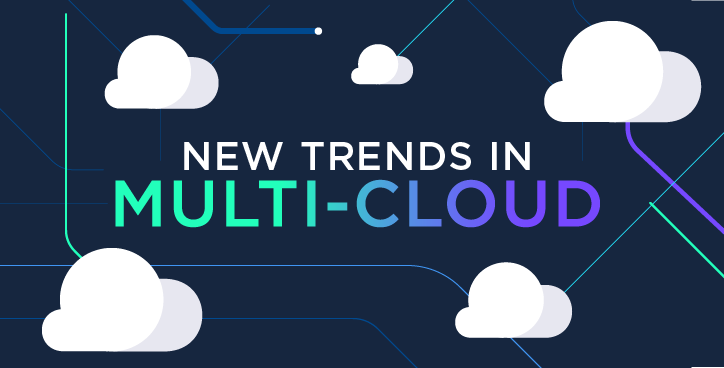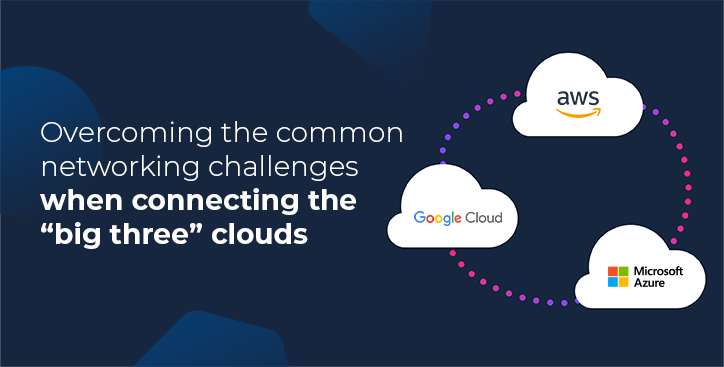New Trends In Multi-Cloud Connectivity
By Alex Hawkes|23 August, 2021

Many enterprises accelerated their multi-cloud strategies in the last 18 months as they grappled with pandemic-induced infrastructure changes. In this blog, we look at some of the new trends in multi-cloud and examine the growing challenge of multi-cloud connectivity.
On a macro level, the multi-cloud trend was already taking hold as public cloud services matured and providers sought to differentiate their offerings, with multi-cloud adoption progressing in tandem as organisations realised they couldn’t, or shouldn’t, put all their eggs in one basket.
The shift to a cloud-first infrastructure has been accelerated by the COVID-19 pandemic, changing long-term migration plans to almost overnight deployments and for some, a complete rethink going forward.
By 2022, over 90% of businesses surveyed by analyst IDC say they intend to pursue the cloud more aggressively, relying on a mix of private clouds, multiple public clouds, and legacy platforms to build business continuity in the wake of the pandemic by adding greater resilience and financial liquidity into their operations.
Furthermore, according to the Flexera 2021 State of the Cloud Report, enterprises are broadly embracing a multi-cloud strategy, with an estimated 92% of companies adopting a multi-cloud approach. The system integrator’s research found that enterprise respondents to its study currently use an average of 2.6 public and 2.7 private clouds within their infrastructure, suggesting multi- and hybrid- setups have become commonplace.
The cloud is not one-size-fits-all
As cloud models reach maturity and widespread adoption, it is becoming increasingly clear that there is no one-size-fits-all model capable of meeting the cost, security, data, and performance expectations of a heterogeneous set of workloads.

In many cases a multi-cloud environment has come about by accident rather than through strategy. An organisation, for example, may have selected Amazon AWS as its Infrastructure-as-a-Service (IaaS) of choice but then might realise it has an Office 365 instance running on Microsoft Azure with staff doing some work in that environment. Factor in the on-prem infrastructure and your business may suddenly be supporting several different cloud environments.
Alternatively, there are those companies who made the deliberate intention to choose multiple cloud providers in order to benefit from the specific strengths of each. In this way you can build a best-of-breed environment with a bespoke architecture.
This model also gives organisations the freedom from the prescriptive architecture of a single cloud provider and makes the cloud a two-way street.
In terms of data portability, the growing popularity of multi-cloud has spawned significant interest in containers and APIs. According to IDC, open-source-based technologies such as containers, open APIs and open source databases are enablers of multi-cloud as they support movement of workloads and data across different cloud environments to ensure portability, compliance and security. As an example, IDC estimates that at least 50% of organisations prefer to run databases on a container platform.
But containerisation in general is seen as a key element of digital transformation as it enables the ability to build applications once and deploy them anywhere, regardless of environment. This gives companies the freedom to choose clouds for their specific strengths and not because a critical application was built for a certain environment.
As mentioned, some of these environments will be on-prem, but multi-cloud is not the same as hybrid cloud.
Hybrid cloud - a combination of public and private cloud instances - is more a subset of multi-cloud and while a hybrid cloud environment is typically also a multi-cloud environment, the same may not be true of the inverse. A company may have multiple public cloud instances and no private data centre for example.
Challenges of multi-cloud connectivity
For many organisations, multi-cloud is inevitable. After all, it’s unlikely there is a single cloud out there that is able to support all your requirements and as we already mentioned, the larger your company, the higher the chance of multi-cloud happening by stealth.
Organisations typically use several, to dozens, to hundreds of SaaS products, as well as a handful of IaaS hosting services, and development PaaS. Some applications will work better on certain platforms - cloud native apps should be happy on AWS, Microsoft Azure or Google Cloud, but traditional apps might prefer Oracle Cloud or IBM Cloud.
 So, a multi-cloud approach enables you to create this best-of-breed environment. But there are also benefits to being able to run workloads across multiple hyperscale cloud environments - something that is being made easier through containerisation.
So, a multi-cloud approach enables you to create this best-of-breed environment. But there are also benefits to being able to run workloads across multiple hyperscale cloud environments - something that is being made easier through containerisation.
The caveat is that success for a multi-cloud environment lies in bringing all the pieces together in harmony. It’s ensuring the right workload is distributed to the most appropriate cloud and making sure all the cloud services can communicate with one another.
Organisations need to establish and understand the core connectivity between, and governance around, these disparate environments.
In some cases this will mean a modification or upgrade of your WAN as legacy WAN architectures are typically very cloud unfriendly and put considerable burden on the organisation to maintain.
Appropriate connectivity for SaaS, IaaS and PaaS is not easily achieved on traditional infrastructure, nor are appropriate SLAs, and a suboptimal WAN can actually degrade the performance of cloud-based applications and adversely affect the end-user experience.
But if done well, using multiple clouds can help avoid vendor lock-in and reduce dependency on a single provider, even leveraging the competitive tension between the different cloud environments to reduce cost and boost service levels.
3 Reasons to go multi-cloud
- Eliminate vendor lock-in: Harness the power of the cloud and get the most value out of your partnership with each service provider
- Best-of-breed suitability: Align your IT requirements with the best cloud providers for each individual task or workload
- Flexibility and scalability: Multi-cloud allows businesses to scale storage and compute up or down based on-demand, as well as shift workloads between environments based on the needs of each data segment
How NaaS can help manage multi-cloud connectivity
Due to the nature and volume of traffic moving between data centres or public clouds, a dedicated, low latency, high bandwidth connection is necessary between each asset.
 Setting up and managing such connections is a mammoth task and Network-as-a-Service (NaaS) offerings, such as PCCW Global’s Console Connect, have emerged to help organisations manage and optimise their network assets from a single pane of glass.
Setting up and managing such connections is a mammoth task and Network-as-a-Service (NaaS) offerings, such as PCCW Global’s Console Connect, have emerged to help organisations manage and optimise their network assets from a single pane of glass.
Data Centre Interconnection is the fabric that connects and protects traffic across and between multiple data centres, allowing organisations to create a distributed topology that serves their applications and content closer to consumers and delivery networks in a highly available and secure fashion.
For both a hybrid and a multi-cloud approach, a NaaS platform can provide real time access to all clouds from enterprise locations around the world, as well as interconnect public cloud instances with your existing data centres and other private clouds.
NaaS, such as Console Connect, enables customers to create private and dedicated connections between their remote network environments, such as private data centres, and public cloud deployments, with easy management from a single console.
In keeping with the scalable nature of the cloud, multiple port speeds from 50Mbps to 10Gbps are available at predictable pricing models that fit every budget. With no more long lead times and restrictive contracts, enterprises can connect from one day to three years and only pay for what you need. Connections and bandwidth can be flexed up and down, on-demand and in real time.
Based on private connectivity that bypasses the public internet, Console Connect provides a better user experience and improves efficiency and performance, leveraging PCCW Global’s Tier 1 network and direct access to a global ecosystem of SaaS, IaaS, and PaaS providers.
While it’s true that a multi-cloud strategy can introduce more network complexity and cloud providers do not generally provide interconnecting networks, NaaS can ensure your business critical applications stay running regardless of public internet performance.
Ultimately, adopting multi-cloud enables you to adapt and pivot your digital strategy regardless of the capabilities of any single cloud platform.
If we consider that the first era of cloud adoption was to migrate and run some applications in the cloud. Then came hybrid cloud, which connected private cloud with public cloud solutions.
The third era is multi-cloud; an architectural approach that enables organisations to pick and choose cloud services based on best-of-breed technology, while giving them the freedom to avoid proprietary pathways ensuring optimal innovation in the future.

.jpg)





.jpg)

